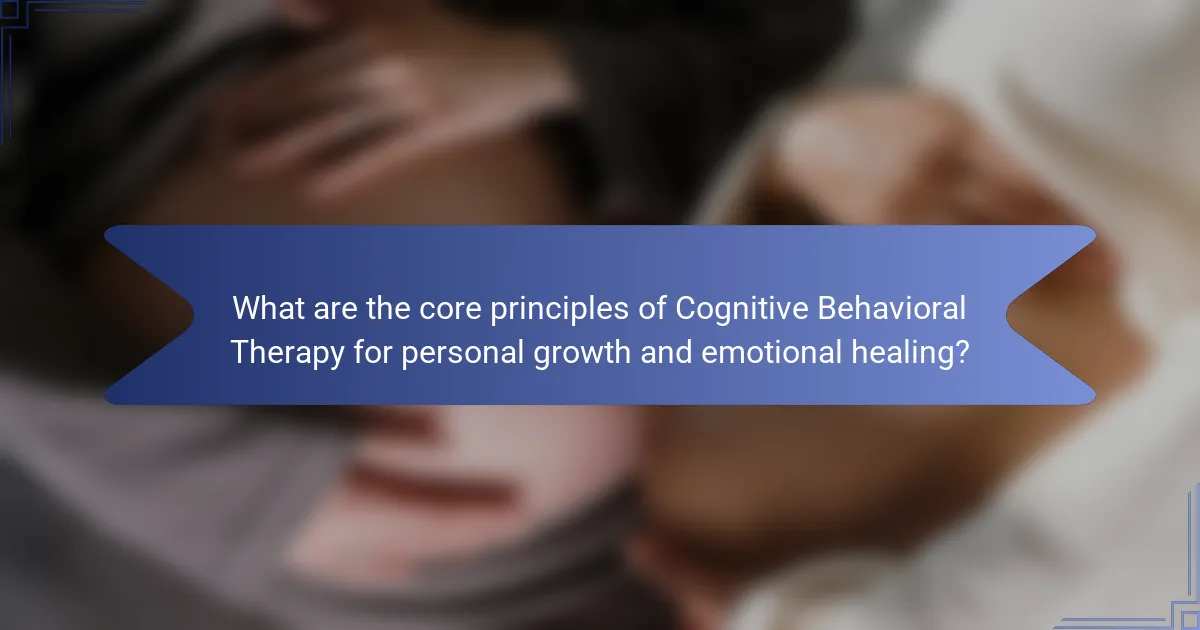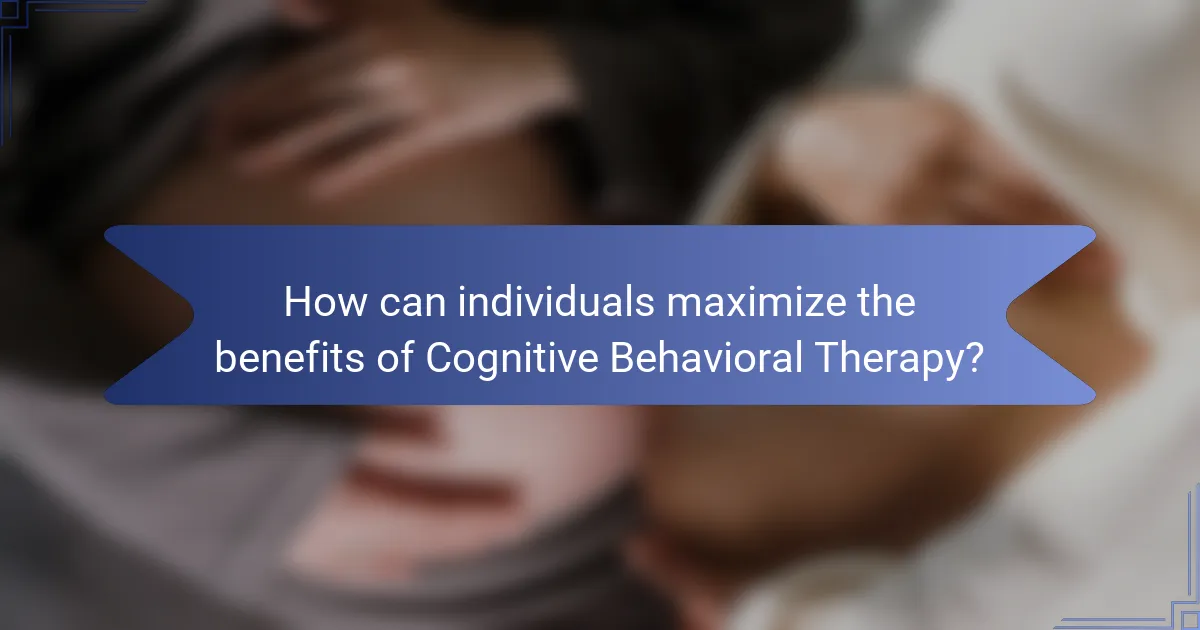Cognitive Behavioral Therapy (CBT) principles empower individuals to reshape thoughts for personal growth and emotional healing. Key aspects include cognitive restructuring to challenge negative thoughts, behavior modification to develop healthier habits, and mindfulness to enhance emotional regulation. This structured approach equips individuals with practical tools for managing stress and anxiety, fostering resilience and self-awareness. Engaging actively in CBT techniques maximizes benefits, promoting lasting mental health improvements.

What are the core principles of Cognitive Behavioral Therapy for personal growth and emotional healing?
Cognitive Behavioral Therapy (CBT) principles focus on reshaping thoughts to foster personal growth and emotional healing. Key principles include cognitive restructuring, behavior modification, and mindfulness.
Cognitive restructuring helps individuals identify and challenge negative thought patterns, leading to improved emotional responses. Behavior modification encourages the development of healthier habits through reinforcement techniques. Mindfulness promotes present-moment awareness, reducing anxiety and enhancing emotional regulation.
These core principles empower individuals to take control of their mental health, fostering resilience and personal development. CBT’s structured approach provides tools for managing emotions and behaviors effectively.
How does Cognitive Behavioral Therapy facilitate emotional healing?
Cognitive Behavioral Therapy (CBT) promotes emotional healing by restructuring negative thought patterns. It helps individuals identify and challenge distorted beliefs, leading to healthier emotional responses. CBT’s structured approach encourages self-reflection and skill development, fostering personal growth. Research indicates that CBT can significantly reduce symptoms of anxiety and depression, enhancing overall well-being.
What role does cognitive restructuring play in personal growth?
Cognitive restructuring is crucial for personal growth as it helps individuals challenge and change negative thought patterns. This process enhances emotional healing by promoting healthier perspectives and coping strategies. By reframing thoughts, individuals can reduce anxiety, improve self-esteem, and foster resilience. Cognitive restructuring also encourages self-awareness, enabling a deeper understanding of one’s emotions and behaviors. This transformative approach ultimately leads to personal empowerment and a more fulfilling life.
What are the steps involved in cognitive restructuring?
Cognitive restructuring involves several key steps to challenge and change negative thought patterns.
1. Identify negative thoughts.
2. Evaluate the evidence for and against these thoughts.
3. Challenge the validity of these thoughts.
4. Replace negative thoughts with more balanced, rational ones.
5. Practice the new thoughts regularly to reinforce change.
How can behavioral activation enhance emotional well-being?
Behavioral activation significantly enhances emotional well-being by promoting engagement in meaningful activities. This approach encourages individuals to identify and participate in activities that align with their values, leading to increased positive emotions and reduced symptoms of depression.
Research shows that by focusing on specific behaviors, individuals can break the cycle of avoidance and low mood. For example, regular physical activity, social interactions, and hobbies can improve mood and foster a sense of accomplishment.
Additionally, behavioral activation helps individuals develop coping strategies, increasing resilience to stress. As a result, this method not only addresses current emotional challenges but also equips individuals with skills for future emotional resilience.
In summary, behavioral activation is a practical tool within cognitive behavioral therapy that enhances emotional well-being through active engagement and positive behavior change.
What techniques are used in behavioral activation?
Behavioral activation employs techniques like activity scheduling, identifying values, and monitoring mood changes. These methods encourage engagement in meaningful activities, counteracting avoidance behaviors. Activity scheduling helps structure daily tasks, while identifying personal values aligns actions with goals. Monitoring mood changes provides feedback on the effectiveness of these activities, promoting emotional healing and personal growth.

What are the universal benefits of Cognitive Behavioral Therapy?
Cognitive Behavioral Therapy (CBT) offers universal benefits such as improved emotional regulation, enhanced coping strategies, and increased self-awareness. These principles empower individuals to challenge negative thought patterns, leading to personal growth and emotional healing. CBT’s structured approach fosters resilience, enabling better management of stress and anxiety. Additionally, it equips individuals with practical skills to navigate life’s challenges effectively.
How does Cognitive Behavioral Therapy improve coping skills?
Cognitive Behavioral Therapy (CBT) enhances coping skills by teaching individuals to identify and challenge negative thought patterns. This process fosters resilience and promotes healthier emotional responses. CBT encourages the development of practical strategies, such as problem-solving and stress management techniques, which are essential for effective coping in daily life. As a result, individuals gain confidence and improved emotional regulation, leading to better overall mental health outcomes.
What impact does Cognitive Behavioral Therapy have on anxiety and depression?
Cognitive Behavioral Therapy (CBT) significantly reduces symptoms of anxiety and depression. It equips individuals with practical skills to identify and challenge negative thought patterns, fostering emotional resilience. Studies show that CBT can lead to a 50% reduction in anxiety and depression symptoms within 12-20 sessions. This therapy emphasizes the connection between thoughts, feelings, and behaviors, promoting healthier coping mechanisms. As a result, individuals often experience improved mood and enhanced overall functioning in daily life.
How can Cognitive Behavioral Therapy promote resilience?
Cognitive Behavioral Therapy (CBT) enhances resilience by equipping individuals with tools to manage stress and negative thoughts. It fosters adaptive coping strategies and promotes a growth mindset, allowing individuals to view challenges as opportunities for personal development. CBT’s structured approach helps identify cognitive distortions and replace them with balanced thinking, which strengthens emotional regulation. As a result, individuals become more adept at navigating life’s adversities, contributing to long-term emotional healing and personal growth.

What unique attributes set Cognitive Behavioral Therapy apart from other therapies?
Cognitive Behavioral Therapy (CBT) is distinguished by its focus on the interplay between thoughts, emotions, and behaviors. This therapy emphasizes practical strategies for addressing negative thought patterns, which is unique compared to other therapeutic approaches.
CBT is structured, time-limited, and goal-oriented, making it efficient for personal growth and emotional healing. It also incorporates techniques such as cognitive restructuring and exposure therapy, which are less emphasized in other modalities.
The unique attribute of CBT is its evidence-based approach, supported by extensive research demonstrating its effectiveness for various mental health conditions. This contrasts with therapies that may rely more on subjective interpretations or long-term processes.
As a result, CBT equips individuals with tools for immediate application, fostering resilience and long-term emotional health.
How does the structured approach of Cognitive Behavioral Therapy aid in goal setting?
Cognitive Behavioral Therapy (CBT) enhances goal setting through its structured approach. This therapy encourages individuals to identify specific, measurable, achievable, relevant, and time-bound (SMART) goals that align with their personal values.
CBT emphasizes breaking down larger goals into smaller, manageable tasks. This method fosters a sense of accomplishment and motivation as individuals progress toward their objectives. Additionally, CBT promotes self-reflection, enabling individuals to evaluate their thoughts and behaviors related to goal achievement.
The unique attribute of CBT is its focus on cognitive restructuring, which helps individuals challenge negative thought patterns that may hinder goal setting. As a result, clients can develop a more positive mindset, enhancing their commitment to personal growth.
Overall, the structured principles of CBT provide a clear framework that supports effective goal setting, leading to emotional healing and personal development.
What is the significance of the therapist-client collaboration in Cognitive Behavioral Therapy?
Therapist-client collaboration is crucial in Cognitive Behavioral Therapy as it enhances trust, engagement, and effectiveness. This partnership empowers clients, fostering a sense of ownership in their healing journey. Collaborative efforts lead to tailored interventions that address unique needs, promoting personal growth and emotional healing. Research shows that strong therapeutic alliances significantly improve treatment outcomes, making collaboration a vital component of successful therapy.

What rare attributes of Cognitive Behavioral Therapy contribute to its effectiveness?
Cognitive Behavioral Therapy (CBT) is effective due to its rare attributes like personalized treatment plans and real-time feedback mechanisms. These attributes allow for tailored approaches that address individual needs, enhancing emotional healing. The integration of technology, such as apps for tracking progress, is another unique aspect that supports self-monitoring and accountability. Additionally, the focus on cognitive restructuring empowers clients to challenge negative thought patterns, fostering resilience. These rare qualities contribute significantly to the overall success of CBT in promoting personal growth.
How does the adaptability of Cognitive Behavioral Therapy cater to individual needs?
Cognitive Behavioral Therapy (CBT) is adaptable, allowing personalized approaches to individual needs. This flexibility enhances emotional healing and personal growth by tailoring techniques to specific issues. For example, CBT can address anxiety, depression, or phobias through customized strategies like cognitive restructuring or exposure therapy. The unique attribute of CBT is its focus on present thoughts and behaviors, enabling clients to develop coping mechanisms that resonate with their experiences. As a result, individuals can engage more effectively in their healing journey, making CBT a valuable tool for diverse emotional challenges.
What role does technology play in modern Cognitive Behavioral Therapy practices?
Technology enhances Cognitive Behavioral Therapy (CBT) by increasing accessibility and engagement. Digital platforms allow for real-time communication between therapists and clients, facilitating immediate support. Mobile apps offer tools for tracking thoughts and behaviors, promoting self-reflection. Virtual reality can simulate anxiety-provoking situations, aiding exposure therapy. These innovations expand the reach of CBT, making it more adaptable to individual needs.

How can individuals maximize the benefits of Cognitive Behavioral Therapy?
To maximize the benefits of Cognitive Behavioral Therapy, individuals should actively engage in the process. Consistent practice of techniques, such as cognitive restructuring and behavioral activation, enhances emotional healing. Setting specific goals allows for measurable progress, while journaling thoughts and feelings supports self-reflection. Regularly attending sessions with a qualified therapist ensures guidance and accountability. Additionally, integrating mindfulness practices can complement CBT, fostering greater awareness and emotional regulation. These strategies collectively empower individuals to achieve personal growth and improved mental health.
What are some best practices for engaging with Cognitive Behavioral Therapy?
Engaging with Cognitive Behavioral Therapy (CBT) involves applying specific techniques to enhance personal growth and emotional healing. Key practices include setting clear goals, identifying and challenging negative thoughts, and practicing behavioral experiments.
Establishing a routine for reflection can deepen insights gained during therapy sessions. Journaling thoughts and feelings helps track progress and reinforces learning. Additionally, practicing mindfulness can enhance self-awareness and emotional regulation, crucial components of CBT.
Collaborating with a therapist to tailor strategies to individual needs ensures effective application of CBT principles. Regularly reviewing and adjusting goals based on personal experiences fosters continuous growth. Engaging in support groups can also provide valuable perspectives and encouragement.
What common mistakes should be avoided during the therapy process?
Avoiding common mistakes during the therapy process enhances the effectiveness of cognitive behavioral therapy. Key mistakes include failing to establish clear goals, not actively participating in sessions, and neglecting homework assignments.
Additionally, clients may misinterpret cognitive distortions, leading to ineffective self-reflection. Another common error is overlooking the importance of open communication with the therapist, which can hinder progress. Lastly, unrealistic expectations about quick results can lead to disappointment and frustration.
How can one effectively track progress in Cognitive Behavioral Therapy?
To effectively track progress in Cognitive Behavioral Therapy, maintain a journal documenting thoughts, feelings, and behaviors. Regularly review this journal to identify patterns and changes over time. Set specific, measurable goals to evaluate progress against. Utilize self-assessment tools, such as questionnaires, to quantify emotional and cognitive shifts. Engage in regular feedback sessions with your therapist to discuss insights and adjustments, ensuring alignment with therapeutic objectives.